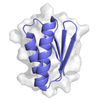+ Open data
Open data
- Basic information
Basic information
| Entry | Database: PDB / ID: 6e9t | ||||||
|---|---|---|---|---|---|---|---|
| Title | DHF58 filament | ||||||
 Components Components | DHF58 filament | ||||||
 Keywords Keywords | PROTEIN FIBRIL / Protein design / filament | ||||||
| Biological species | synthetic construct (others) | ||||||
| Method | ELECTRON MICROSCOPY / helical reconstruction / cryo EM / Resolution: 5.4 Å | ||||||
 Authors Authors | Lynch, E.M. / Shen, H. / Fallas, J.A. / Kollman, J.M. / Baker, D. | ||||||
 Citation Citation |  Journal: Science / Year: 2018 Journal: Science / Year: 2018Title: De novo design of self-assembling helical protein filaments. Authors: Hao Shen / Jorge A Fallas / Eric Lynch / William Sheffler / Bradley Parry / Nicholas Jannetty / Justin Decarreau / Michael Wagenbach / Juan Jesus Vicente / Jiajun Chen / Lei Wang / Quinton ...Authors: Hao Shen / Jorge A Fallas / Eric Lynch / William Sheffler / Bradley Parry / Nicholas Jannetty / Justin Decarreau / Michael Wagenbach / Juan Jesus Vicente / Jiajun Chen / Lei Wang / Quinton Dowling / Gustav Oberdorfer / Lance Stewart / Linda Wordeman / James De Yoreo / Christine Jacobs-Wagner / Justin Kollman / David Baker /   Abstract: We describe a general computational approach to designing self-assembling helical filaments from monomeric proteins and use this approach to design proteins that assemble into micrometer-scale ...We describe a general computational approach to designing self-assembling helical filaments from monomeric proteins and use this approach to design proteins that assemble into micrometer-scale filaments with a wide range of geometries in vivo and in vitro. Cryo-electron microscopy structures of six designs are close to the computational design models. The filament building blocks are idealized repeat proteins, and thus the diameter of the filaments can be systematically tuned by varying the number of repeat units. The assembly and disassembly of the filaments can be controlled by engineered anchor and capping units built from monomers lacking one of the interaction surfaces. The ability to generate dynamic, highly ordered structures that span micrometers from protein monomers opens up possibilities for the fabrication of new multiscale metamaterials. | ||||||
| History |
|
- Structure visualization
Structure visualization
| Movie |
 Movie viewer Movie viewer |
|---|---|
| Structure viewer | Molecule:  Molmil Molmil Jmol/JSmol Jmol/JSmol |
- Downloads & links
Downloads & links
- Download
Download
| PDBx/mmCIF format |  6e9t.cif.gz 6e9t.cif.gz | 1.7 MB | Display |  PDBx/mmCIF format PDBx/mmCIF format |
|---|---|---|---|---|
| PDB format |  pdb6e9t.ent.gz pdb6e9t.ent.gz | 1.4 MB | Display |  PDB format PDB format |
| PDBx/mmJSON format |  6e9t.json.gz 6e9t.json.gz | Tree view |  PDBx/mmJSON format PDBx/mmJSON format | |
| Others |  Other downloads Other downloads |
-Validation report
| Summary document |  6e9t_validation.pdf.gz 6e9t_validation.pdf.gz | 1.1 MB | Display |  wwPDB validaton report wwPDB validaton report |
|---|---|---|---|---|
| Full document |  6e9t_full_validation.pdf.gz 6e9t_full_validation.pdf.gz | 1.2 MB | Display | |
| Data in XML |  6e9t_validation.xml.gz 6e9t_validation.xml.gz | 142.6 KB | Display | |
| Data in CIF |  6e9t_validation.cif.gz 6e9t_validation.cif.gz | 178.1 KB | Display | |
| Arichive directory |  https://data.pdbj.org/pub/pdb/validation_reports/e9/6e9t https://data.pdbj.org/pub/pdb/validation_reports/e9/6e9t ftp://data.pdbj.org/pub/pdb/validation_reports/e9/6e9t ftp://data.pdbj.org/pub/pdb/validation_reports/e9/6e9t | HTTPS FTP |
-Related structure data
| Related structure data |  9017MC  9016C  9018C  9019C  9020C  9021C  6e9rC  6e9vC  6e9xC  6e9yC  6e9zC M: map data used to model this data C: citing same article ( |
|---|---|
| Similar structure data |
- Links
Links
- Assembly
Assembly
| Deposited unit | 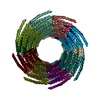
|
|---|---|
| 1 |
|
| Symmetry | Helical symmetry: (Circular symmetry: 2 / Dyad axis: no / N subunits divisor: 1 / Num. of operations: 12 / Rise per n subunits: 9.10835 Å / Rotation per n subunits: 40.93287 °) |
- Components
Components
| #1: Protein | Mass: 25273.379 Da / Num. of mol.: 24 Source method: isolated from a genetically manipulated source Source: (gene. exp.) synthetic construct (others) / Production host:  |
|---|
-Experimental details
-Experiment
| Experiment | Method: ELECTRON MICROSCOPY |
|---|---|
| EM experiment | Aggregation state: FILAMENT / 3D reconstruction method: helical reconstruction |
- Sample preparation
Sample preparation
| Component | Name: DHF58 filament / Type: COMPLEX / Entity ID: all / Source: RECOMBINANT |
|---|---|
| Source (natural) | Organism: synthetic construct (others) |
| Source (recombinant) | Organism:  |
| Buffer solution | pH: 8 |
| Specimen | Embedding applied: NO / Shadowing applied: NO / Staining applied: NO / Vitrification applied: YES |
| Specimen support | Details: unspecified |
| Vitrification | Cryogen name: ETHANE |
- Electron microscopy imaging
Electron microscopy imaging
| Experimental equipment | 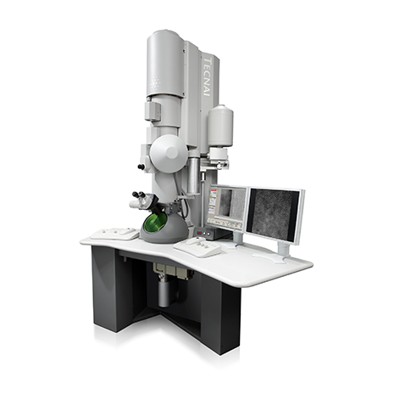 Model: Tecnai F20 / Image courtesy: FEI Company |
|---|---|
| Microscopy | Model: FEI TECNAI F20 |
| Electron gun | Electron source:  FIELD EMISSION GUN / Accelerating voltage: 200 kV / Illumination mode: FLOOD BEAM FIELD EMISSION GUN / Accelerating voltage: 200 kV / Illumination mode: FLOOD BEAM |
| Electron lens | Mode: BRIGHT FIELD |
| Image recording | Electron dose: 45 e/Å2 / Detector mode: COUNTING / Film or detector model: GATAN K2 SUMMIT (4k x 4k) |
- Processing
Processing
| EM software |
| |||||||||||||||
|---|---|---|---|---|---|---|---|---|---|---|---|---|---|---|---|---|
| CTF correction | Type: PHASE FLIPPING ONLY | |||||||||||||||
| Helical symmerty | Angular rotation/subunit: 40.93287 ° / Axial rise/subunit: 9.10835 Å / Axial symmetry: C2 | |||||||||||||||
| 3D reconstruction | Resolution: 5.4 Å / Resolution method: FSC 0.143 CUT-OFF / Num. of particles: 76994 / Symmetry type: HELICAL | |||||||||||||||
| Atomic model building | Protocol: RIGID BODY FIT |
 Movie
Movie Controller
Controller






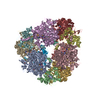
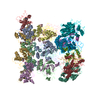

 PDBj
PDBj